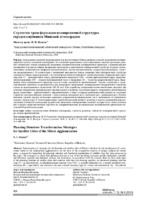Стратегии трансформации планировочной структуры городов-спутников Минской агломерации
Another Title
Planning Structure Transformation Strategies for Satellite Cities of the Minsk Agglomeration
Bibliographic entry
Жолудь, Н. И. Стратегии трансформации планировочной структуры городов-спутников Минской агломерации = Planning Structure Transformation Strategies for Satellite Cities of the Minsk Agglomeration / Н. И. Жолудь // Наука и техника. – 2020. – № 5. – С. 400-406.
Abstract
Определение стратегий формирования городов-спутников Минска является основой для развития полицентрической модели столичной агломерации. На основании проведенного сопоставительного анализа проектных решений генеральных планов предложена концепция совершенствования планировочной структуры и функциональной организации городов-спутников. Концепция заключается в адаптации их планировочной структуры к одному из перспективных экономических профилей (промышленному, научно-промышленному, аграрно-промышленному, туристско-рекреационному). В соответствии с концепцией выделяются четыре основных типа планировочной структуры городов-спутников, коррелирующих с их градообразующими спецификами: урбанизированная планировочная структура (тип У) – промышленный город, урбанизированно-природная (УП) – научно-промышленный город, природно-урбанизированная (ПУ) – аграрно-промышленный город и природная (П) – туристско-рекреационный город. Выделенные типы планировочной структуры легли в основу стратегий их преобразований. Термин «стратегия» в градостроительном контексте подразумевается как генеральное направление трансформации планировочной структуры города на долговременную перспективу (20–30 лет). При разработке генеральных планов необходимо выделять два основных направления трансформации: преобразование и развитие. Реализация первого направления обеспечивается двумя стратегиями – фрагментацией и дефрагментацией, а также четырьмя разновидностями каждой из стратегий. Стратегии пространственного развития – консолидация, векторный рост, секторный рост, радиальный рост. Особое внимание уделено анализу возможных вариантов размещения функциональных зон в зависимости от удаленности города от города-ядра. С учетом выделенных стратегий пространственного развития и анализа размещения городов-спутников в Минской агломерации разработаны двенадцать планировочных моделей, которые могут использоваться при создании градостроительных проектов по совершенствованию функционально-планировочной организации поселений Минской агломерации.
Abstract in another language
Determination of strategies for the formation of satellite cities of Minsk is the basis for the development of a polycentric model of the metropolitan agglomeration. On the basis of the comparative analysis of design solutions for master plans, a concept for improving the planning structure and functional organization of satellite cities has been proposed in the paper. The concept is to adapt their planning structure to one of the promising economic profiles (industrial, scientific and industrial, agrarian and industrial, tourism and recreation). In accordance with the concept, there are four main types of the planning structure of satellite cities that correlate with their city-forming specifics: an urbanized planning structure (type У) – an industrial city, an urbanized-natural structure (type УП) – a scientific-industrial city, a natural-urbanized structure (type ПУ) – agricultural and industrial city and a natural structure (type П) – tourist and recreational city. The selected types of planning structure have formed the basis of strategies for their transformation. The term “strategy” in the urban planning context is understood as the general direction of the transformation of the city’s planning structure for the long period (20–30 years). While developing master plans, it is necessary to distinguish two main directions of transformation: transformation and development. The implementation of the first direction is provided by two strategies – fragmentation and defragmentation as well as four varieties of each strategy. Spatial development strategies are consolidation, vector growth, sector growth, radial growth. Particular attention is paid to the analysis of possible options for the placement of functional zones, depending on the distance of the city from the core city. Taking into account the identified strategies for spatial development and analysis of the location of satellite cities in the Minsk agglomeration, twelve planning models have been developed that can be used to create urban planning projects to improve the functional planning organization of settlements in the Minsk agglomeration.
View/
Collections
- № 5[12]

